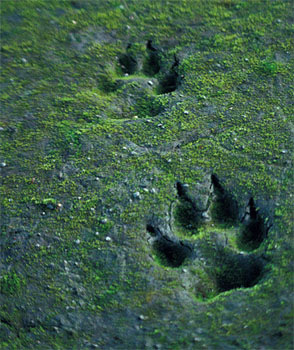 Something that I touched on only briefly in my Hexcrawl series was the subject of tracks: The system I use for encounter generation features the ability to create random encounters, lairs, and tracks. Random encounters provide immediate obstacles and interludes while traveling; lairs spontaneously generate new locations in the hexcrawl (organically building up material along well-traveled routes as the campaign develops); and tracks are a trail that can be followed to a point of interest.
Something that I touched on only briefly in my Hexcrawl series was the subject of tracks: The system I use for encounter generation features the ability to create random encounters, lairs, and tracks. Random encounters provide immediate obstacles and interludes while traveling; lairs spontaneously generate new locations in the hexcrawl (organically building up material along well-traveled routes as the campaign develops); and tracks are a trail that can be followed to a point of interest.
What I didn’t really extrapolate on is the fact that the concept of “tracks” isn’t necessarily limited to hoof prints in the sod. In the wilderness exploration of the hexcrawl that sort of physical spoor is most likely very common, but the concept of “tracks” really generalizes to “clue”. For example, if I generated a result of “tracks” for bandits that might include a merchant caravan in panicked disarray due to their latest highway robbery; the dead body of a bandit that was critically wounded and abandoned; a bolt-hole containing documents implicating the mayor of a local village in collusion with the bandits; and so forth.
Roger the GS recently posted “Almost Encounters: Sights, Sounds, and Leavings” which breaks this sort of thing down into some useful categories:
- Sights (“a pair of griffins flying across the sunset, many miles away”; “a brief red glow, sighted across a far-away ridge line”)
- Sounds (“snatches of shouting and song down in the valley”)
- Body Parts
- Victims
- Tracks
- Smells and Vapors
- Environment Damage
- Intentional Markings
Check it out. There are a lot of great examples over there.













In my Entity Definition template the ‘Description’ section explicitly includes an area for ‘signature’, signs that a particular entity (creature, thing, place) may be involved or have been present somewhere.
For instance, Palavirea, a particular wand of fireball, launches fireballs that are vivid green and smell of maple syrup… and leave the now-fireballed area slightly sticky and smelling of burned syrup. It can be determined that the Kreshtar, a tribe of nomadic horse-riding orcs, was in the area by the nature of the tracks and spoor they leave, and the damage done to those foolish enough to fight them.
Having ‘indirect descriptions’ of things can be a powerful tool.
Relevant to the hex crawl series is Roger’s system for handling encounters. It’s inspired. I use it in play, with a slight modification to have a truly random encounter:
http://rolesrules.blogspot.com/2011/04/one-page-wilderness-system.html
And here’s the example, which really shows it off:
http://rolesrules.blogspot.com/2011/04/one-page-wilderness-in-action.html